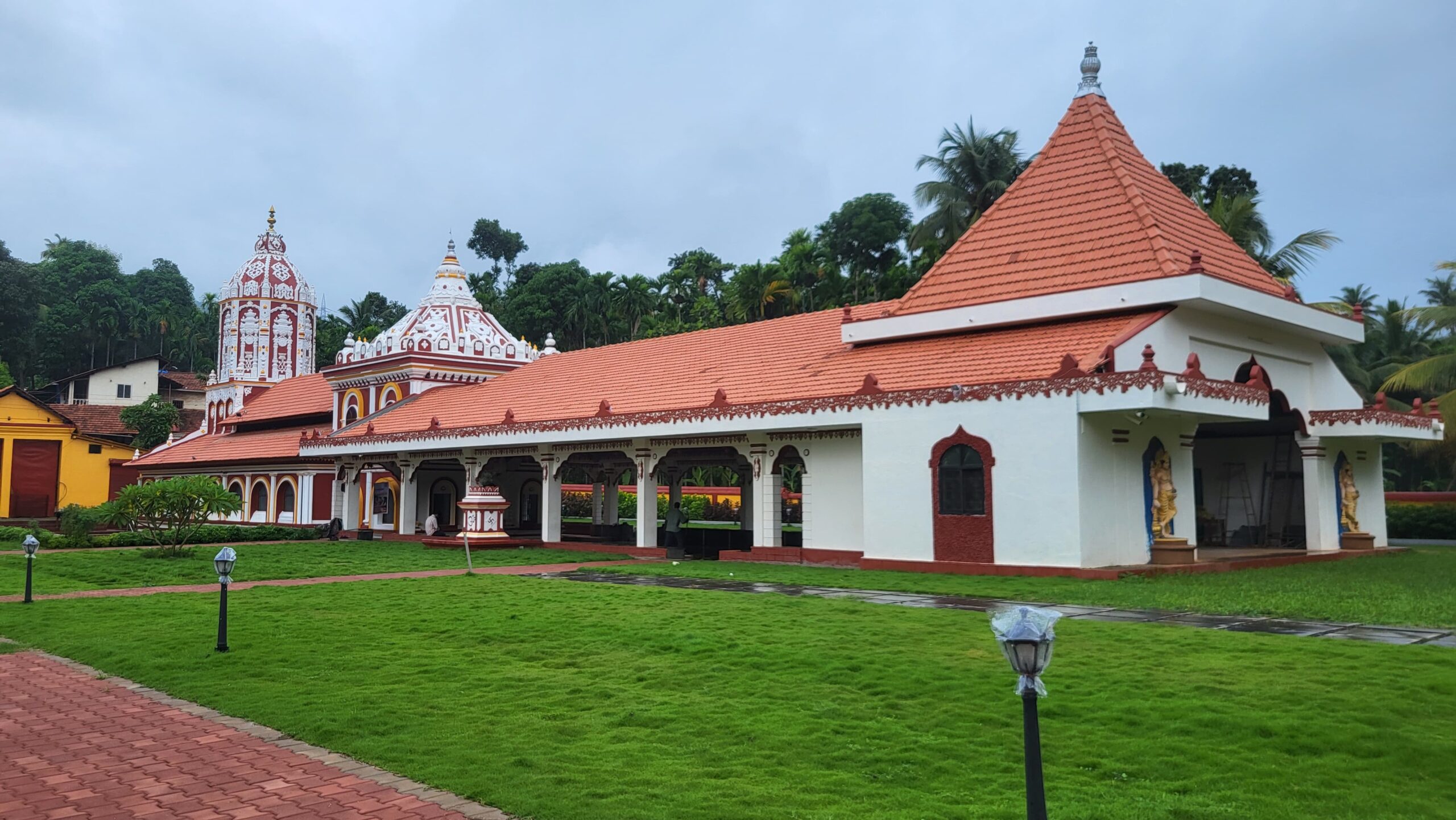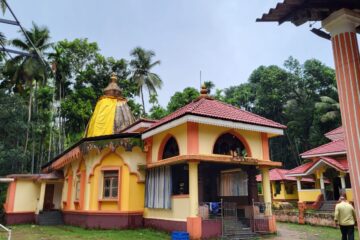Kuldevi Mahalasa Narayani
Mahalasa Narayani – my family deity. From both my maternal and marital side. Before marriage, the main reason for visiting Goa was to seek her blessings. Once that was done, we’d squeeze in a bit of sightseeing.
Later by her grace, she became my Kuldevi from my husband’s side as well. And fate would have it that my marital home was just 25 kilometers from her temple, in Panaji.
My love and reverence for her grew even stronger after she became my Kuladevi through my in-laws. Initially, we’d visit Mardol two or three times a year. But over time, my bond with Mahalasa became so deep that now I visit the temple countless times.
Even if I set aside the fact that she’s our family deity, there’s something so magnetic about her temple – especially the idol of Mahalasa adorned in different ornaments every day – that it keeps drawing me back again and again.
The Origin of Mahalasa and the Sacred Legacy of Mardol
Mahalasa originally hails from Varenyapuri — what we now know as Verna. During the Portuguese rule, when many deities had to be moved to protect them from religious persecution, Mahalasa was relocated to Mardol.
As described in the Sahyadri Khanda of the Skanda Purana, Parashurama brought ten Saraswat families from Trihotra in the north to the land of Gomantak. These families brought their family deities with them, who came to be revered as kuldevatas — including Mangeshi, Mahalasa, Mahalakshmi, Mahadev, Shantadurga, Nagesh, and Saptakoteshwar. Later, more Saraswat families arrived with their respective Kuldevatas, making a total of sixty-six families, six of which settled in Varenyapur, now Verna.
Next to the Mahalasa temple in Mardol stands another temple — that of Shanteri Devi. Local lore tells us that Shanteri, the original presiding deity of Mardol, welcomed Mahalasa from Verna and offered her a place beside her. Because of this legend, many devotees first visit Shanteri Devi before proceeding to seek blessings from Mahalasa. Even today, the daily rituals begin with the aarti of Shanteri Devi. This is followed by worship at smaller shrines behind the main Mahalasa temple, dedicated to Gramapurusha, Shri Bhagwati, Chatushashti Yoginis, Kalbhairav, Shri Dadh, and others — only then is the aarti of Mahalasa performed.

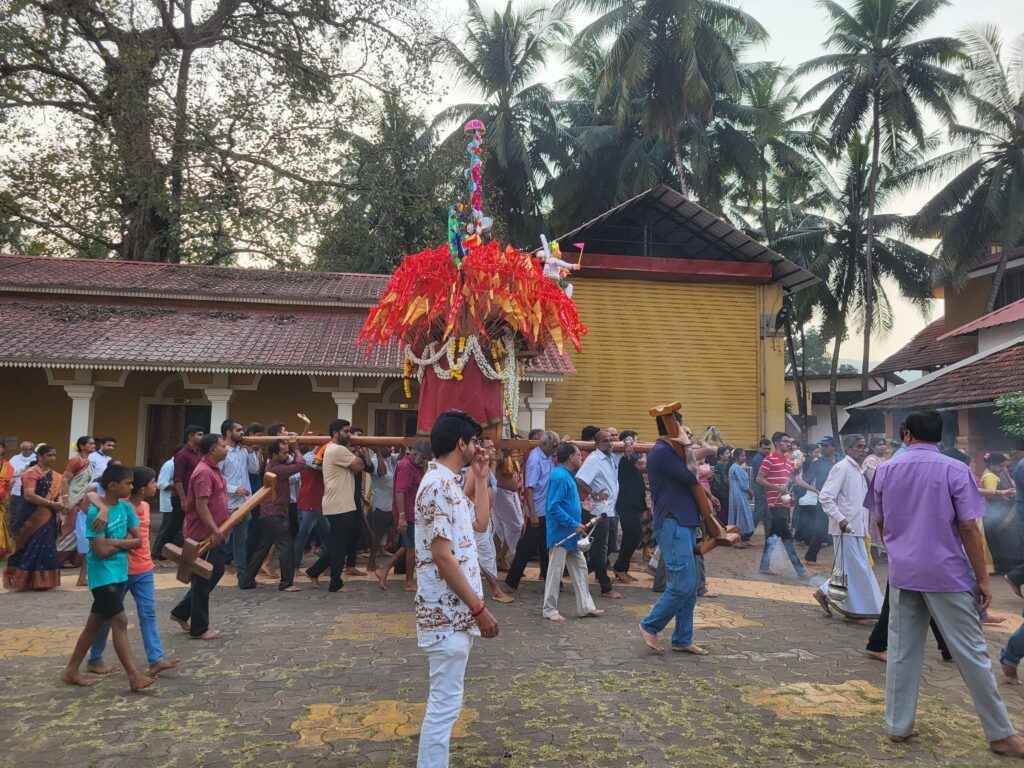
Who is Mahalasa Narayani?
Many visitors from outside Goa often find themselves wondering — who exactly is this goddess Mahalasa? I’ve seen tourists at the temple ask this very question. Some assume she is the wife of Khandoba, while others, noticing the similarity in names, believe she is a form of Mahalakshmi.
To truly understand who Mahalasa of Mardol is, we need to go back to the tale of the Samudra Manthan —the churning of the ocean. When the pot of nectar (Amrit) emerged from the ocean, a fierce battle broke out between the gods and demons over who would claim it. To help the gods, Lord Vishnu took the form of Mohini — a stunningly beautiful enchantress. Her beauty mesmerized the demons, and while they were distracted, she distributed the nectar among the gods.
But the demon Rahu saw through the illusion. Disguising himself as a god, he tried to consume the nectar. Mohini noticed this and instantly severed his head from his body.
The Mahalasa of Mardol is none other than this mesmerizing Mohini. The idol shows a four-armed goddess wearing a sacred thread (Yajnopavita). Her upper right hand holds a trident (Trishul), and the other carries the pot of nectar. In her front right hand, she holds a sword and the hair of the kneeling demon Virochan, while her left hand holds Rahu’s severed head, from which blood drips — and a tiger is shown drinking it. She stands triumphantly over the body of a fallen demon.
Mahalasa is the perfect embodiment of beauty, brilliance, and bravery — all in one divine form.
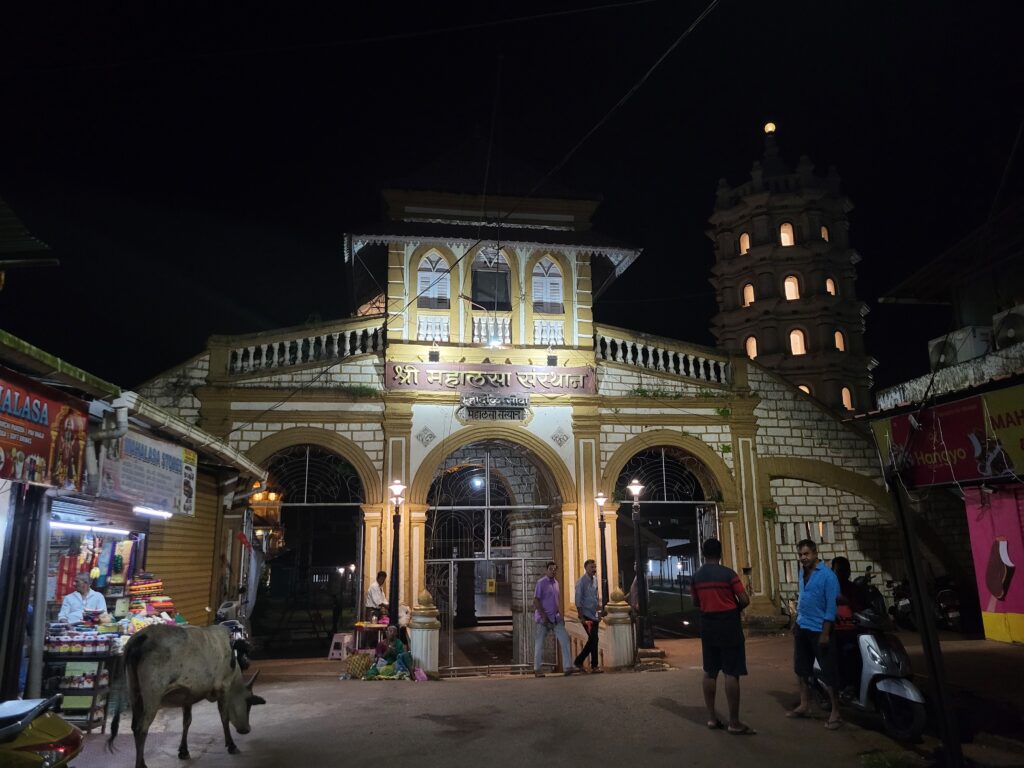
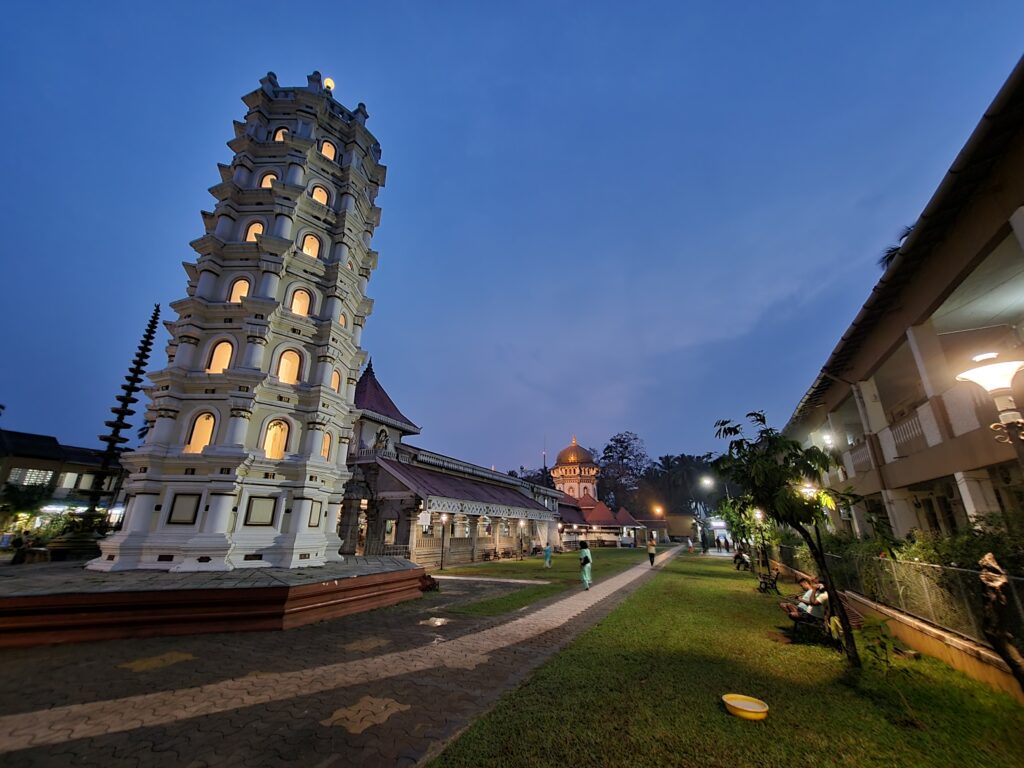
The Timeless Architecture and Divine Energy of the Mahalasa Narayani Temple
The Mahalasa Narayani temple in Mardol is nearly 450 years old. While the main structure of the original temple remains intact, there have been several internal upgrades over time. For instance, the sanctum’s front doorway, along with the surrounding walls on both sides and above, is now adorned with silver plating. The main sanctum door itself is covered in gold. The spire (kalash) atop the Mahalasa temple is made of gold. The dome beneath the spire is made of brass, and copper has been used for the roofing. Even the pyramid-shaped roofs above the entranceways on either side of the Chowk are made of copper. The combination of gold, copper, and brass in the temple’s design adds a special vibrancy to the spiritual energy within.
The current front hall (sabhamandap), along with the temples of Hanuman, Navagraha (Nine Planets), and the Yajna Mandap, were all constructed many years after the original structure. The temple, set within a beautifully maintained courtyard, features a highly striking main entrance. This grand gateway is adorned with an intricately carved idol of the four-armed Goddess Mahalasa.
Above the entrance is a small room meant for musicians to play traditional instruments like the shehnai and chaughada (ceremonial drums). This room is known as the Nagarkhana. A similar Nagarkhana can also be seen at the Vijayadurga Temple in Keri.
As you step through the main gateway, your eyes are immediately drawn to a tall metal Deepmala (lamp tower), which is lit during festivals. Just behind it, directly in front of the main Mahalasa temple, is a small Hanuman shrine. Between the Deepmala and the Hanuman temple stands a beautifully crafted flagpole, with a larger Deepstambh (lamp pillar) nearby.
Upon entering the temple, you’re greeted by a spacious assembly hall, lined with stone pillars on both sides and at the front. Above the entry into this hall, there’s a detailed carving of Vishnu in his reclining form (Sheshashayi Vishnu). On the opposite wall, at the centre, is a stunningly detailed four-armed sculpture of Mahalasa, commanding attention and reverence.
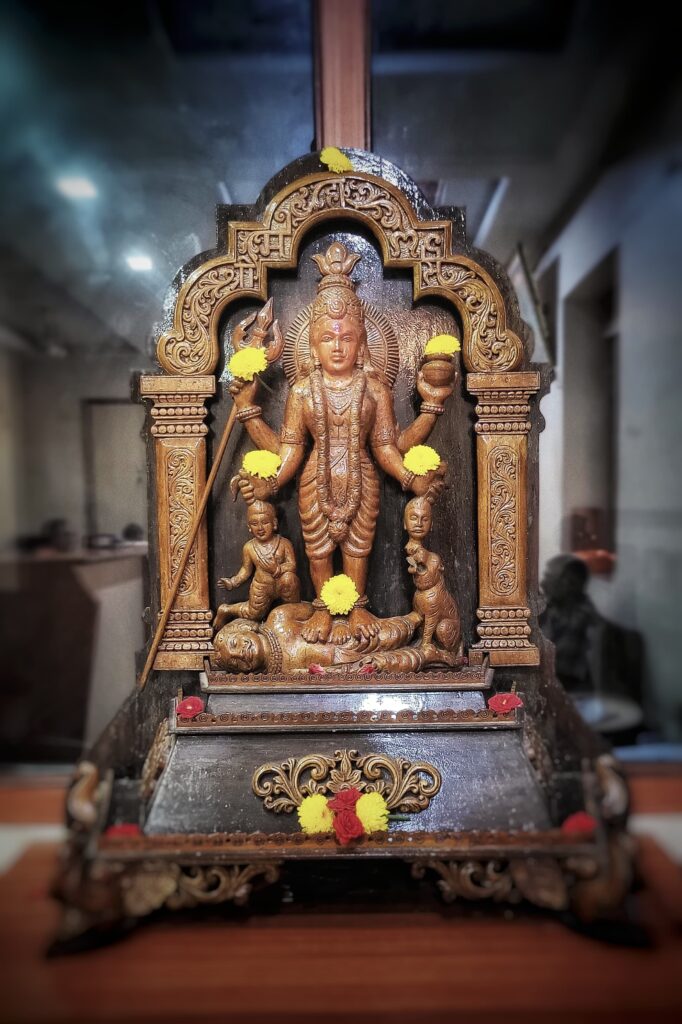

Madhyamandap: The Heart of Divine Architecture
From here, we enter the antaral or inner hall of the temple. In the Mahalasa temple, this space houses traditional instruments like the nagāra and tāshe (large ceremonial drums), as well as the palanquin used for the goddess. These instruments are played from this area during the aarti (ritual worship), filling the temple with a rhythmic, spiritual energy. On both sides of this hall, stairways lead up to raised platforms in the outer hall.
Moving ahead, we step into the Chowk or Madhyamandap – the central hall that faces the sanctum of the temple. The entrance of this chowk has large windows on both sides, and the space itself is framed with beautifully carved wooden pillars.The roof above is also made of beautifully crafted wood adding to the temple’s warm, organic charm. What sets this Chowk apart from others is the exquisite wooden sculptures of various deities, carved into all four sides.
A unique feature of this temple, unlike most others, is that instead of having regular windows on both sides of the Chowk, there are long wooden planks resembling seating ledges. Behind these planks are intricately carved wooden railings, which allow light and air to circulate through the Chowk, creating a serene and sacred atmosphere.
A Glimpse of the Divine: The Sanctum and the Enchanting Idol of Mahalasa
On either side of the silver doorway that leads to the sanctum, you’ll find intricate engravings of Goddess Lakshmi and Saraswati, along with auspicious symbols — all crafted on silver panels. Above the door is a detailed depiction of the Samudra Manthan (churning of the ocean). Just beside this entrance, slightly to the outside, stand the divine gatekeepers, Jai and Vijay.
Beyond this silver doorway lies another door, and then the entrance to the sanctum itself. This inner entrance is beautifully adorned with gold-plated carvings, and stepping through it, one is greeted by the breathtakingly adorned idol of Goddess Mahalasa.
If you wish to see the original Shaligram idol (a sacred stone form), that darshan is possible early in the morning — usually until around 9 or 9:30 a.m., before the abhishek (ritual bathing) and decoration begin. After that, the goddess is dressed in elaborate ornaments. Each day, she is adorned in a different set of decorations, and the artistry is so exquisite that no matter how many times you see her, it never feels like enough. The creativity and devotion of the priest who does this daily adornment truly deserves admiration — it’s nothing short of divine craftsmanship.
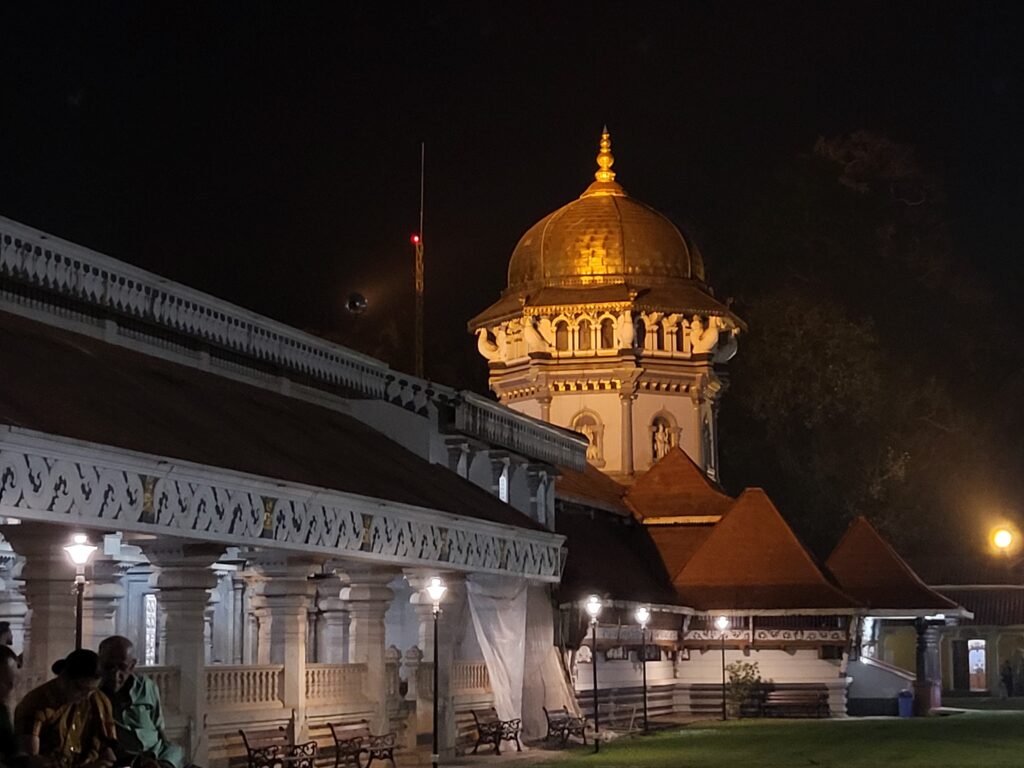
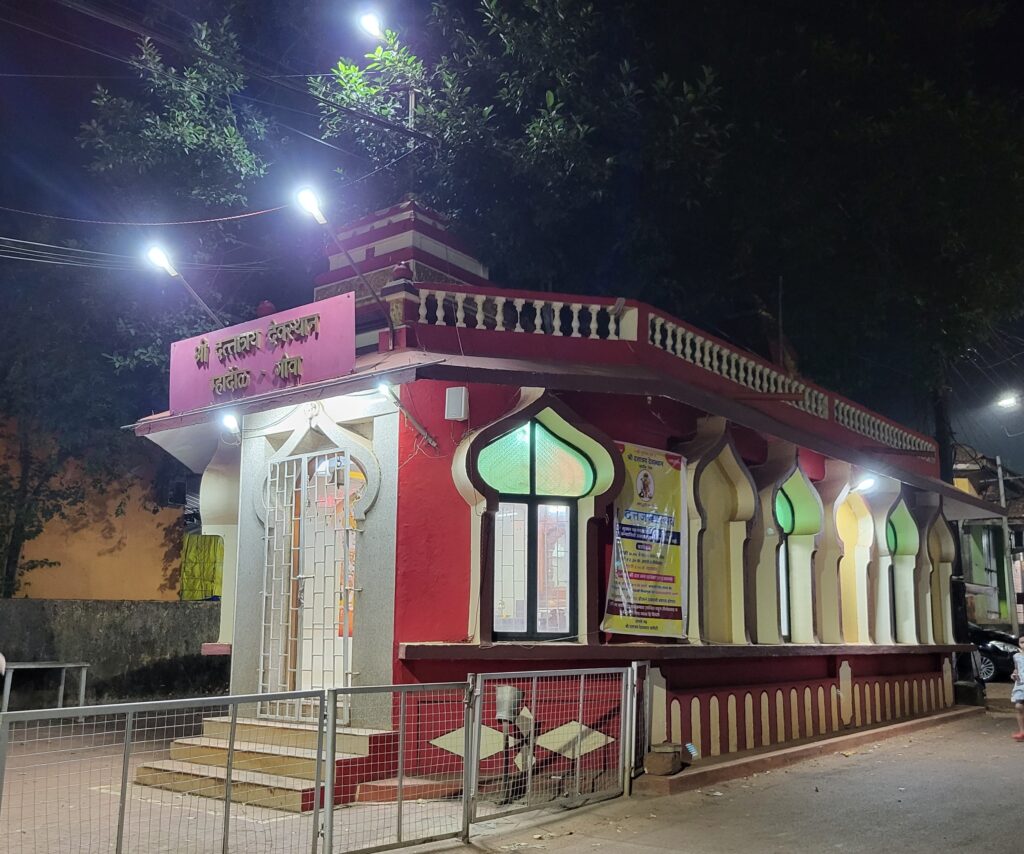
The Legendary Brass Bell: A Symbol of Divine Justice
One of the most fascinating features of the Mahalasa Narayani temple is the massive brass bell, which has its clapper (the part that rings) removed. This bell wasn’t just a ritual object; during the Portuguese rule in Goa, it was used as an instrument of justice.
The story behind the bell is that anyone who gave false testimony while ringing he would die within three days. As a result, even during the Portuguese regime, testimonies given in the temple were considered valid in court. Whenever someone wanted to give testimony, the clapper would be attached to the bell.
To this day, this bell can still be seen in the temple.— a silent yet powerful reminder of truth, justice, and the divine presence that watches over all.
The Serene and Well-Equipped Temple Complex
The entire temple complex is charming. On both sides, there are accommodations for devotees, a canteen, residences for the priests, administrative offices, and even a hall meant for ceremonies like weddings and thread ceremonies (munj).
As you enter the temple premises, to the left stands the recently renovated and beautifully restored temple of Goddess Shantadurga. On the right, just before the canteen, a path leads to the temple of Simha Purusha, the guardian deity of the Kaushik gotra families. Just beyond this is the newly constructed Simha Purusha Hall and additional guest rooms.
Right outside the temple’s main entrance, on the roadside, you’ll find a small but charming Dattatreya temple, nestled under the shade of a sacred Audumbar tree. Along this road, a number of small hotels and shops line both sides, adding a welcoming, village-like feel to the spiritual atmosphere.
Various Programs at the Temple
Throughout the year, the Mahalasa Narayani Temple is alive with a variety of religious events and vibrant festivities. Among the most significant are the Jaya Puja during the month of Shravan, the beautifully decorated Makhar during Navratri in Ashwin, the Festival of Lights (Deepotsav) in Kartik, the grand Champa Shashti Rath Yatra in Margashirsha, and a five-day fair (Jatra) dedicated to the goddess in the month of Magh. There’s also the celebration of Mahashivratri and the colorful Rang Panchami festival in Phalgun.
In addition to these, every Sunday features a ceremonial procession of Mahalasa’s palanquin, while on every Panchami, there’s a procession for Goddess Shantadurga. Daily rituals include afternoon and evening aartis for both Shantadurga and Mahalasa.
If you haven’t yet visited this beautiful and spiritually rich temple in Mardol, make sure to plan a visit soon — it’s an experience not to be missed.
